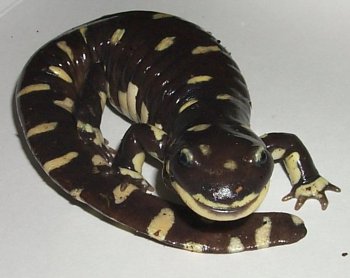The main motivation to conduct the outgoing phase of my Marie Skłodowska-Curie fellowship at the University of California, Los Angeles was to design a ‘sequence capture by target enrichment’ pipeline for Triturus. At UCLA, Evan McCartney-Melstad and Brad Shaffer possess the necessary experience as they use this technique for their system of hybridizing tiger salamanders (genus Ambystoma). Adapting the pipeline to Triturus went superbly and the first paper based on this dataset has now been published in Molecular Phylogenetics and Evolution.
 California tiger salamander (Ambystoma californiense) by the Shaffer lab
California tiger salamander (Ambystoma californiense) by the Shaffer lab
Triturus is an example of an adaptive radiation: the more slender a species’ body build, the longer its annual aquatic period. This suggests a causal relationship between body build evolution and ecological specialization. While adaptive radiations provide some of the best examples of evolution in action (think Darwin finches and cichlid fishes), the relationships between the species involved are notoriously difficult to decipher. This problem also applies to Triturus: despite several attempts, the phylogeny was hitherto unresolved, hampering our ability to retrace the eco-morphological evolution in Triturus.

The new Triturus tree (the newt pictures are by Michael Fahrbach)
With our ‘sequence capture by target enrichment’ pipeline we can sequence about 6000 DNA markers for the genus Triturus. To try and resolve the Triturus phylogeny we obtained a dataset including representatives of all marbled and crested newt species. Three distinct tree-building methods each recovered the same Triturus tree. Now we were able to place Triturus’ eco-morphological divergence into an evolutionary context: the red arrows on the Triturus tree above show inferred additions of trunk vertebrae, resulting in more slender and aquatic bodies. Our results show that the genus gradually evolved more elongated and aquatic newts. Nice!
Reference: Wielstra, B., McCartney-Melstad, E., Arntzen, J.W., Butlin, R.K., Shaffer, H.B. (2019). Phylogenomics of the adaptive radiation of Triturus newts supports gradual ecological niche expansion towards an incrementally aquatic lifestyle. Molecular Phylogenetics and Evolution 133: 120-127.


Pingback: Refining the range dynamics of the Italian crested newt | Wielstra Lab